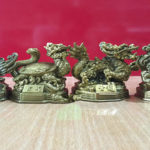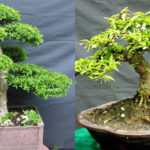The Royal Poinciana, or Delonix regia, is a magnificent tree species native to the lush forests of Madagascar. Also known as the flame tree or peacock flower, this tree is widely cultivated in Vietnam and other tropical regions for its stunning ornamental value and shade. Standing tall at 10-20 meters, the Royal Poinciana boasts a broad canopy of dense, interlacing branches. Its distinctive foliage consists of intricate, bipinnate leaves resembling a peacock’s tail, hence its nickname.
1 Introduction to the Royal Poinciana
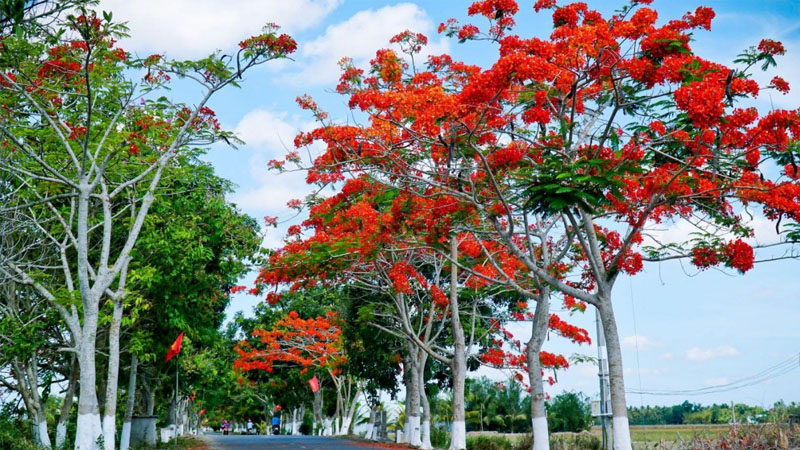 The Royal Poinciana is native to Madagascar
The Royal Poinciana is native to Madagascar
With its vibrant red flowers and majestic presence, the Royal Poinciana is an iconic tree that holds a special place in the hearts of many. Its scientific name, Delonix regia, translates to “royal maiden,” reflecting its elegant beauty. This tree is native to the lush rainforests of Madagascar, located off the southeastern coast of Africa. It thrives in tropical and subtropical climates and has become a beloved fixture in Vietnam, where it is widely cultivated for its aesthetic and functional qualities.
The Royal Poinciana is a deciduous tree, shedding its leaves during the dry season to conserve water. Its grayish-white bark and expansive canopy make it a striking addition to any landscape. The tree’s height typically ranges from 10 to 20 meters, and its branches form a wide, dense canopy that provides ample shade.
The leaves of the Royal Poinciana are its most distinctive feature. They are bipinnate, resembling a feather or a peacock’s tail, with small, dense, bright green leaflets arranged in a pinnate pattern. This unique foliage creates a lush, textured look that sets the tree apart from others.
The tree’s show-stopping flowers are another highlight. Blooming in clusters up to 50 centimeters long, the flowers feature five petals, with the largest one bearing a distinctive white pattern. The petals are a vibrant red, with a slightly ruffled edge, creating a fiery display. The flowers are followed by large, brown pods up to 60 centimeters in length, containing edible seeds.
Adaptable and resilient, the Royal Poinciana thrives in tropical and subtropical climates. Its ability to store water allows it to endure both saline and drought conditions, making it a versatile species.
2 Significance of the Royal Poinciana
 The Royal Poinciana is often associated with students and education
The Royal Poinciana is often associated with students and education
In Vietnam, the Royal Poinciana holds a special significance, particularly for students. Known as the “student flower,” it symbolizes the joys and sorrows of student life and marks the end of the school year and the arrival of summer. Its vibrant red blooms serve as a reminder of the fleeting nature of youth and the importance of cherishing memories.
During the summer holidays, students often collect the fallen petals, carefully pressing and drying them to create butterfly-shaped mementos to exchange as tokens of friendship. This tradition adds to the sentimental value associated with the Royal Poinciana.
In the Vietnamese language, the tree’s name, “phượng vĩ,” translates to “tail of the phoenix,” a mythical bird associated with rebirth and renewal. This name is derived from the tree’s striking foliage, which resembles the tail of a phoenix in flight. The vibrant red flowers, resembling flames, further enhance this association.
Haiphong, a city in northern Vietnam, is particularly renowned for its abundance of Royal Poinciana trees. It has earned the nickname, “City of Red Poinciana,” reflecting the deep connection between the tree and the local culture.
3 Practical Uses of the Royal Poinciana
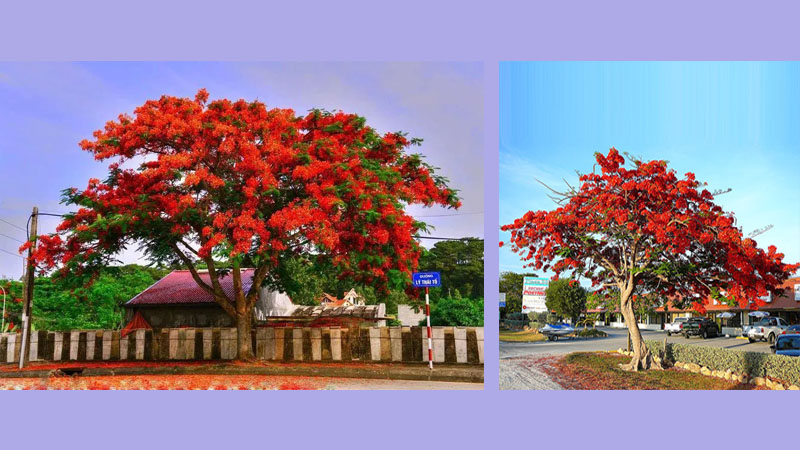 The Royal Poinciana provides shade and enhances the aesthetic value of spaces
The Royal Poinciana provides shade and enhances the aesthetic value of spaces
The Royal Poinciana is prized for its ability to provide ample shade and enhance the aesthetic value of any space. Its wide canopy and dense foliage make it an ideal choice for parks, school grounds, and streets, offering a respite from the sun and a visually appealing landscape.
Beyond its ornamental value, the Royal Poinciana is also sought after by bonsai enthusiasts. Its miniature versions, carefully pruned and shaped, are highly valued for their unique beauty and are considered a symbol of good luck and prosperity.
Additionally, the wood of the Royal Poinciana has practical applications. It is used in carpentry and woodworking to create various objects, from furniture to coffins. The tree’s bark and leaves also have medicinal properties, with the bark being used to treat fevers, high blood pressure, and joint pain, while the leaves are said to aid in digestion and relieve constipation.
4 Planting and Caring for the Royal Poinciana
Planting Techniques
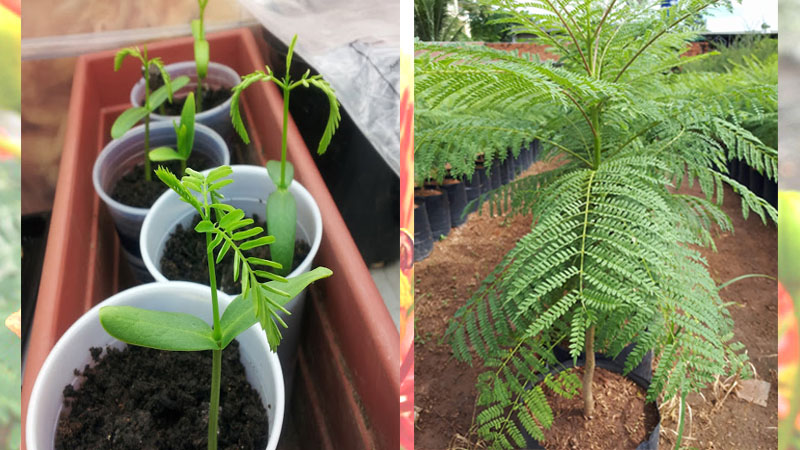 The Royal Poinciana is typically propagated from seeds
The Royal Poinciana is typically propagated from seeds
Propagating the Royal Poinciana is typically done through seeds, making it a relatively straightforward process. Here are the steps to successfully plant and nurture this magnificent tree:
Soak the seeds in warm water for 10-12 hours to stimulate germination. After soaking, wrap the seeds in a clean cotton cloth to encourage sprouting.
Once the seeds begin to crack open, transfer them to a tray filled with slightly moist sand. Bury the seeds gently and cover them with a thin layer of straw or hay.
Within a week, you’ll notice the seeds sprouting above the sand. At this point, remove the layer of straw and maintain moisture in the sand by regular watering. Note: Avoid exposing the seeds to direct sunlight during this stage.
After 2-3 weeks of careful tending, the seedlings will be ready for transplantation to their permanent location.
Prepare the planting hole in advance, approximately one month ahead. Dig a hole measuring 60 x 60 x 60 centimeters and enrich the soil with a mixture of well-rotted compost (500-150kg per hole) and NPK fertilizer (0.1kg of 30-30-30 formula per hole).
When transplanting, hold the seedling firmly and press it gently into the soil to ensure it stands upright. Stake the tree to provide support and stability for the first 4-5 months until it can stand on its own.
Care Instructions
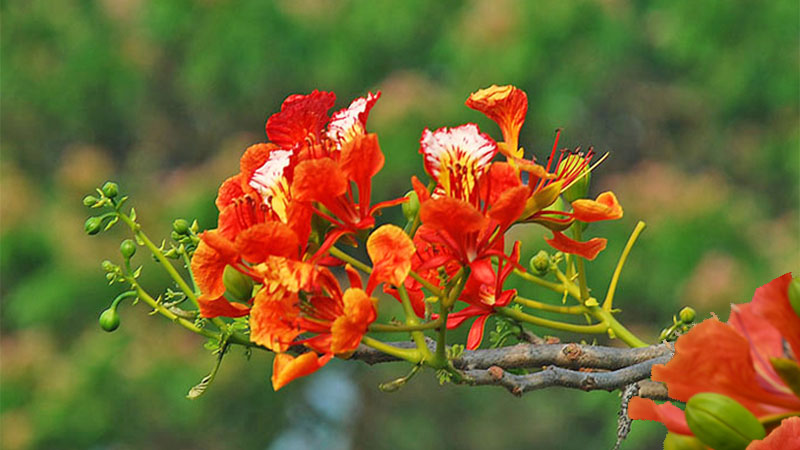 Increase fertilizer application when the tree is about to flower
Increase fertilizer application when the tree is about to flower
Soil
While the Royal Poinciana can adapt to various soil types, it thrives best in a mixture of well-aerated soil combined with organic matter such as compost, green manure, or well-rotted compost in an 80:20 ratio.
Watering
Water the tree daily, preferably in the morning, when it is young. As it matures, increase the frequency to twice a day. Note: During hot and dry periods, you may need to water more frequently, but avoid watering at noon to prevent water loss due to evaporation.
Fertilizer
Apply NPK fertilizer regularly until the tree reaches maturity. When the tree is about to flower, switch to NPK 16-16-8 fertilizer and apply it twice a day for 90 days. Ensure that you water the tree frequently during this period to help dissolve and distribute the fertilizer effectively. Fertilization can be discontinued during winter, as the tree will naturally shed its leaves and enter a dormant phase.
Pest Control
The Royal Poinciana is susceptible to leaf-eating and wood-boring insects. Keep a close eye on the tree, especially when new leaves are about to emerge, and spray insecticides as needed. Note: Always choose pesticides that are safe for the environment and follow the instructions on the package carefully.
5 Captivating Images of the Royal Poinciana
 The Royal Poinciana’s flowers have five petals with slightly ruffled edges
The Royal Poinciana’s flowers have five petals with slightly ruffled edges
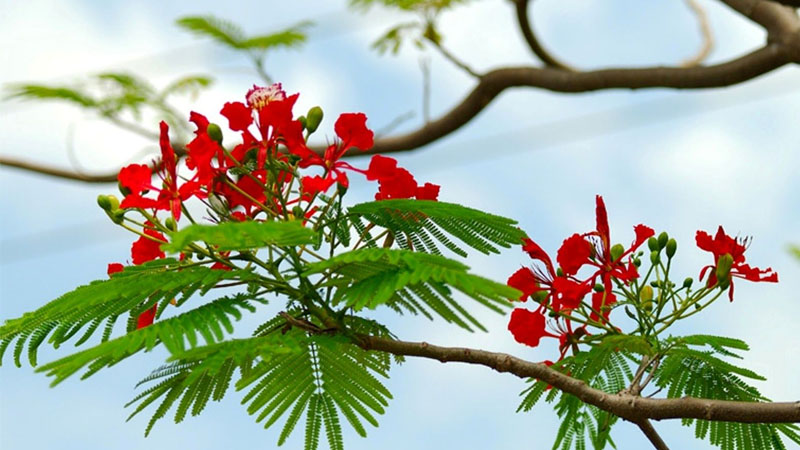 The tree’s leaves grow in clusters, resembling a peacock’s tail
The tree’s leaves grow in clusters, resembling a peacock’s tail
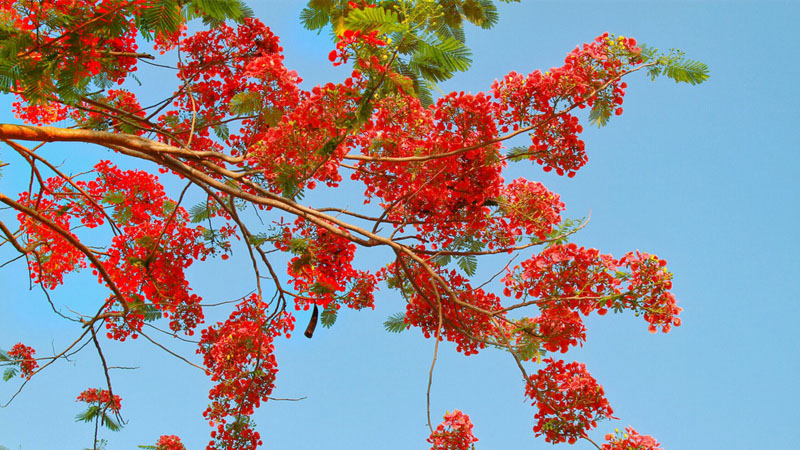 The vibrant red flowers of the Royal Poinciana signal the arrival of summer
The vibrant red flowers of the Royal Poinciana signal the arrival of summer
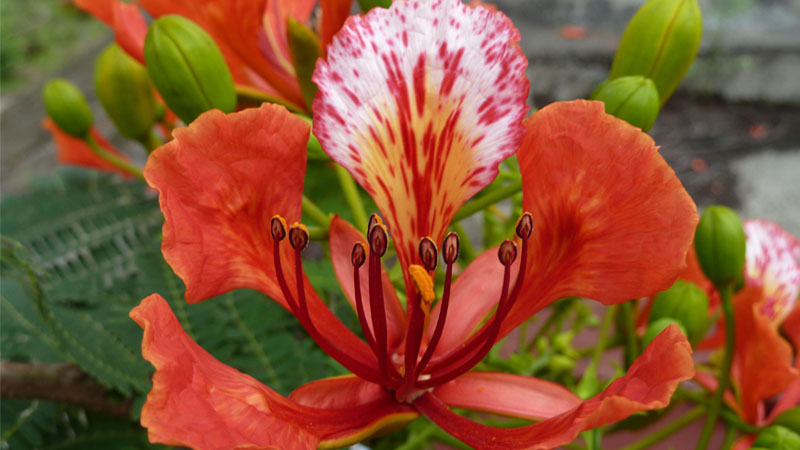 The largest petal of each flower features a distinctive white pattern
The largest petal of each flower features a distinctive white pattern
In conclusion, the Royal Poinciana is a remarkable tree species that captivates with its beauty and cultural significance. Whether it’s the nostalgic memories it evokes among students or its practical uses in daily life, this tree has become an integral part of Vietnamese culture. If you’re inspired to add a touch of tropical splendor to your surroundings, follow the planting and care instructions provided above to cultivate your very own Royal Poinciana tree.
The Surprising Benefits and Cultural Significance of Mai Chieu Thuy: A Guide to Growing This Majestic Plant
The Chinese Banyan, also known as the “Ficus Microcarpa”, is a popular choice for an indoor bonsai tree. This fascinating plant has captured the hearts of many, and it’s time to uncover the meanings and benefits it holds. Let’s explore the wonders of this unique species and discover why it has become a beloved addition to our indoor spaces.
The Royal Pink: Unveiling its Unique Traits, Classification, Significance and Cultivation Secrets
Let’s embark on an exploration of the enchanting Rosa chinensis, commonly known as the ‘Tree of Love’ or the ‘Brilliant Pink’. This exquisite shrub boasts vibrant pink blooms that are a sight to behold, and its delicate fragrance adds to its allure. Beyond its aesthetic appeal, the Rosa chinensis holds cultural significance, symbolizing love, passion, and prosperity. Discover the secrets to cultivating and caring for this magnificent shrub, and unlock the beauty of the Rosa chinensis in your own garden.
The Power and Significance of the Dragon and Phoenix in Feng Shui
“The majestic dragon and phoenix statues are not just decorative pieces but hold a special place in many households. These iconic symbols are believed to bring a host of benefits and positive energy, as outlined in the principles of Feng Shui. Discover the hidden powers and significance of these statues and learn how they can bring prosperity and good fortune to your family.”

























